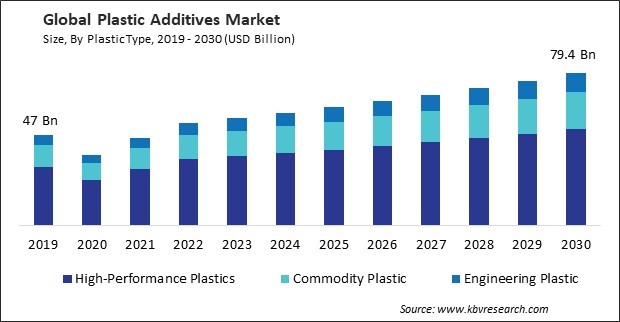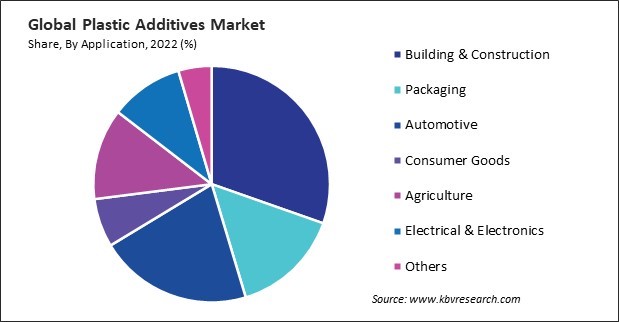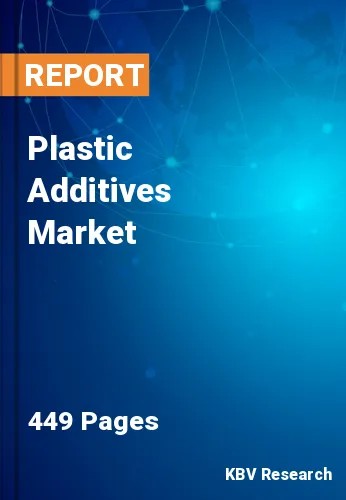“Global Plastic Additives Market to reach a market value of USD 79.4 Billion by 2030 growing at a CAGR of 5.2%”
The Global Plastic Additives Market size is expected to reach $79.4 billion by 2030, rising at a market growth of 5.2% CAGR during the forecast period. In the year 2022, the market attained a volume of 18,151.0 Kilo tonnes, experiencing a growth of 4.6% (2019-2022).
Lubricants serve as processing aids in producing plastic materials, facilitating smoother and more efficient manufacturing processes. Therefore, the lubricants segment captured $3,136.5 million revenue in the market in 2022. By reducing friction between polymer chains and between the polymer and processing equipment, lubricants enhance the flow properties of plastics during extrusion, injection molding, and other processing techniques. As a result, there will be increased demand in the segment.

Different industries have diverse performance requirements for plastic products. For instance, the automotive sector may require plastics with improved mechanical strength and UV resistance, while the packaging industry may prioritize barrier properties and flexibility. Plastic additives help tailor the performance characteristics of plastics to meet these specific needs, contributing to the overall efficiency and effectiveness of the end products. Additionally, innovations in polymer science have led to the creation of additives with multifunctional properties. Rather than relying on multiple additives for different purposes, manufacturers can simultaneously incorporate multifunctional additives to achieve various enhancements. This not only streamlines the manufacturing process but also improves additives' overall efficiency and cost-effectiveness. As new polymers are developed, there is a need for additives that are compatible with these emerging materials. Advances in polymer science ensure that additives can be tailored to work seamlessly with a wide range of polymers, expanding the possibilities for material engineers and manufacturers. These factors will boost the demand in the plastic additives market.
However, the concern over microplastic pollution in oceans, rivers, and soil has prompted governments and environmental agencies to take stricter measures. Plastic additives contribute to the formation of microplastics, which can have adverse effects on ecosystems and wildlife. Governments worldwide are implementing and strengthening regulations to address plastic pollution. These regulations often target specific types of plastic additives, especially those associated with persistent environmental harm. Likewise, the prices of petroleum-based raw materials are often denominated in U.S. dollars. The cost of importing these basic materials may be impacted by currency exchange rate fluctuations, particularly for manufacturers operating in nations where currencies do not have a fixed peg to the U.S. dollar. These factors will reduce the demand for plastic additives in the coming years.
On the basis of plastic type, the plastic additives market is divided into commodity plastic, engineering plastic, and high-performance plastics. The high-performance plastics segment recorded the maximum revenue share in 2022. High-performance plastics are designed to meet stringent requirements in industries with demanding operating conditions. In sectors such as aerospace and automotive, where weight reduction, thermal stability, and mechanical strength are crucial, the adoption of high-performance plastics is on the rise. Therefore, the segment will grow rapidly in the upcoming years.

Based on application, the plastic additives market is divided into packaging, automotive, agriculture, building & construction, consumer goods, electrical & electronics, and others. The automotive segment procured a substantial revenue share in 2022. Plastic compounds are indispensable in the fabrication of vehicle interior components. Plasticizers, flame retardants, and colorants are frequently employed to improve interior components' flexibility, safety, and visual attractiveness, including dashboards, door panels, seats, and ornamentation. These additives contribute to creating comfortable, visually appealing, and durable interiors. These factors will pose lucrative growth prospects for the segment.
Based on type, the plastic additives market is segmented into plasticizers, flame retardants, impact modifiers, lubricants, antioxidants, antimicrobials, UV stabilizers, and others. The impact modifiers segment procured a significant revenue share in 2022. The automotive industry is a major consumer of impact modifiers. These additives enhance the impact resistance of various components, such as bumpers, dashboards, interior trims, and exterior panels. As automotive manufacturers strive to produce lightweight vehicles without compromising safety, the demand for impact modifiers has increased significantly. Thus, these factors will boost the demand in the segment.
Free Valuable Insights: Global Plastic Additives Market size to reach USD 79.4 Billion by 2030
By region, the plastic additives market is segmented into North America, Europe, Asia Pacific, and LAMEA. The North America segment procured a considerable revenue share in the plastic additives market in 2022. North America remains at the forefront of technological advancements in various industries. Innovations such as smart additives, antimicrobial properties, and high-performance functionalities are gaining traction in the market. The region's strong focus on research and development contributes to introducing advanced additives that meet evolving market needs. Thus, these factors will boost the demand in the segment.
| Report Attribute | Details |
|---|---|
| Market size value in 2022 | USD 53.2 Billion |
| Market size forecast in 2030 | USD 79.4 Billion |
| Base Year | 2022 |
| Historical Period | 2019 to 2021 |
| Forecast Period | 2023 to 2030 |
| Revenue Growth Rate | CAGR of 5.2% from 2023 to 2030 |
| Quantitative Data | Volume in Kilo Tonnes, Revenue in USD Million, and CAGR from 2019 to 2030 |
| Number of Pages | 449 |
| Number of Tables | 873 |
| Report coverage | Market Trends, Revenue Estimation and Forecast, Segmentation Analysis, Regional and Country Breakdown, Porter’s 5 Forces Analysis, Company Profiling, Companies Strategic Developments, SWOT Analysis, Winning Imperatives |
| Segments covered | Type, Plastic Type, Application, Region |
| Country scope |
|
| Companies Included | BASF SE, Exxon Mobil Corporation, Clariant AG, Kaneka Corporation, Lanxess AG, The Dow Chemical Company, Evonik Industries AG (RAG-Stiftung), Songwon Industrial Co., Ltd., Nouryon (Carlyle and GIC.), Albemarle Corporation |
By Plastic Type (Volume, Kilo Tonnes, USD Billion, 2019-2023)
By Application (Volume, Kilo Tonnes, USD Billion, 2019-2023)
By Type (Volume, Kilo Tonnes, USD Billion, 2019-2023)
By Geography (Volume, Kilo Tonnes, USD Billion, 2019-2023)
This Market size is expected to reach $79.4 billion by 2030.
Technological advancements in polymer science are driving the Market in coming years, however, Fluctuating raw material prices restraints the growth of the Market.
BASF SE, Exxon Mobil Corporation, Clariant AG, Kaneka Corporation, Lanxess AG, The Dow Chemical Company, Evonik Industries AG (RAG-Stiftung), Songwon Industrial Co., Ltd., Nouryon (Carlyle and GIC.), Albemarle Corporation
In the year 2022, the market attained a volume of 18,151.0 Kilo tonnes, experiencing a growth of 4.6% (2019-2022).
The Building & Construction segment is leading the Market by Application in 2022; thereby, achieving a market value of $21.4 billion by 2030.
The Asia Pacific region dominated the Market by Region in 2022, and would continue to be a dominant market till 2030; thereby, achieving a market value of $41.9 billion by 2030.
Our team of dedicated experts can provide you with attractive expansion opportunities for your business.

 Drivers
Drivers
 Restraints
Restraints
 Opportunities
Opportunities
 Challenges
Challenges
